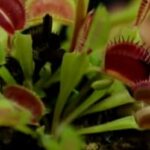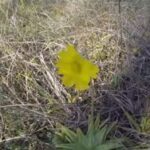As an Amazon Associate, this site earns commissions from qualifying purchases. For more details, click here.
Butterworts produce mucus on their leaves to catch and eat prey. So if your plant is not getting any bugs, check the leaves. If it is dry, you have to find out why your butterworts are not sticky. This guide explains the reasons why pinguicula leaves dry up and what you can do to fix it. And as you will see, it is not that hard.
Lack of humidity is the most common reason why butterwort leaves are not sticky. Adding more water to the plant will increase humidity and should resolve this problem. You can also use a humidifier if the plant is indoors.
How to Increase Humidity
Butterworts require humidity to produce mucus, with 50%-80% ideal for many variants. Some butterworts will thrive in low humidity – 30% or even lower – as long as the roots are kept moist and there is good airflow.
However, lack of humidity can lead to loss of mucus. If your pinguicula weser plants are no longer sticky, low humidity is the most likely reason. They prefer medium to high levels so that is the ideal setting. If the moisture is low and there is poor airflow, it will affect the plant.
Solution. The remedy is to check the recommended humidity level for your plant. This information is included in the care sheet along with other instructions. If it says 60% with good airflow, then that is what you should aim for.
Humidity and air circulation go hand in hand. If the humidity level suggestion is high, you must provide adequate airflow. If the recommendation is low humidity, airflow is less important but still vital. You can also use a humidifier like the Elechomes SH8830 if your butterworts is indoors.
How Humidity Affects Pinguicula Sticky Leaves
If you ask growers the ideal humidity level for butterworts, you will get different answers. Some will say pinguicula sethos grows best in 70% or higher levels, while others will tell you their pinguicula grows in the low 20s. Why the disparity?
There are many reasons for this. One, there are a lot of pinguicula variants. Butterworts can be divided into three basic types: tropical or Mexican, temperate and warm temperate.
Each of these has various variants and hybrids with their own requirements. In general, tropical butterworts thrive in warm climate while temperate naturally grow in places with freezing winters. Because of this, the ideal humidity level varies widely among butterworts.
The other reasons are air circulation and moisture. Air is good for plants and butterworts are no exception. Among other things, it ensures high humidity will not adversely affect the plant.
When humidity is high, the pinguicula glands can produce more mucus for its leaves. However, too much moisture makes it vulnerable to root rot. Butterworts have small, fragile roots which need to be constantly moist, but excessive dampness is also risky.
With good air circulation this situation can be prevented. However if humidity is low, air circulation is less important. If the plant receives plenty of light, water and the right soil, it will continue to grow.
Lack of Water
Knowing how often to water butterworts is essential not just for its survival but to keep its leaves sticky. Because there are many variants you have to manage the water level carefully.
Tropical butterworts – you can use the tray method for these plants during growth season. You may also water overhead to keep its leaves sticky or greasy. During winter, tropical butterworts transform into non-carnivorous succulents and need less water.
Temperate and warm temperate butterworts – similar to tropical butterworts, the tray method is acceptable in spring, summer and fall. In winter these plants form a hibernacula and require very little water.
Some pinguicula variants should be completely dry during dormancy. Other species benefit from having lightly damped soil in winter. Because water requirements can be very specific, your approach will vary depending on the plant.
How you water butterworts has a direct effect on mucus production. It is also key to successful propagation so it must be done properly.
Pinguicula leaves benefit from water, but too much of it can damage roots. Here are some tips.
- If you are going to use the tray method, use only an inch of water. If this keeps the soil moist, do not water from the top. Replenish the water when it empties. Doing this will keep pinguicula leaves sticky without damaging the roots.
- Water from the top if the tray method is not sufficient. Use as much water as necessary to moisten the soil.
- Butterworts need moist, not soggy soil. Too much water will damage the plant.
- Use only purified, spring, distilled or reverse osmosis water. Rainwater is an excellent choice. Avoid tap water.
Watering helps increase mucus production, but do not focus on that. Concentrate on keeping the soil moist. Do this and its mucus production will increase.
How Sticky Should Butterworts Be?
Pinguicula leaves are not really sticky, but more oily or greasy. Sundews for instance, really feel sticky if you touch it, but butterworts are not.
The word pinguicula comes from the Latin pinguis, which means greasy or oily. So do not worry if the leaves do not stick to your finger. As long as the surface is greasy the plant is fine.
Some butterworts are stickier than others, particularly Mexican pings such as P. parvifolia, P. heterophylla, P. medusina and P. gypsicola. In general, tropical butterworts with thread-like leaves are stickier than other species. Hybrids and cross breeds involving any of these variants also produces sticky-leaf butterworts.
If you have any of these butterworts, they should have healthy leaves, almost as much as sundews. If not, the plant lacks humidity or water.
If you pinguicula does not have thread-like leaves, expect the surface to be more greasy or oily. Even if the leaves are not sticky, it is enough to catch small insects.
A close examination of pinguicula leaves reveal the glistening mucus, which resemble water droplets. Insects looking for water will be drawn to this. Once a fly lands on a leaf for example, it gets stuck on the surface.
To our fingers the leaf feels greasy, but it is enough to trap small insects. As the insect struggles to escape, its actions trigger the release of digestive enzymes. These enzymes dissolve the insect, allowing the plant to digest it.
It is from these insects that pinguicula get their nutrition. While there are many variants they all catch and digest bugs in the same way.
Tips on How to Keep Butterworts Sticky
- A healthy, environment is essential for butterworts to make mucus. Humidity and water are crucial but so is light, soil and air. High humidity and plenty of water cannot help if your pinguicula does not get sufficient light.
- Eating insects gives butterworts more resources to produce mucus. And the more mucus its leaves have the more bugs it can catch. It is a cycle that is healthy for these plants.
- Do not fertilize the soil. You can however, mix a bit of fertilizer with water and spray on the leaves. Try to avoid getting any on the soil and apply carefully. Done properly this can lead to rapid growth.
- If your pinguicula goes dormant, it will not eat. So there is no need for the plant to make mucus.
- A lot of factors affect pinguicula health. The more the plant has to adjust to its environment, the harder it will be to create oily leaves. So the best approach is to grow pinguicula that is natural in your region. If not naturally growing, at least its habitat has to be easy to replicate in your environment (the humidity, temperature etc).
- If you see signs of root rot or insect infestation, prune the rotting/dead roots and repot. Remove all the pests before repotting. You can also use Neem Organics to get rid of pests.
Because butterworts depend on mucus to catch prey, you have to make sure the leaves are sticky or at least greasy. Even though pinguicula plants may survive without eating bugs, they will thrive when nourished with insect nutrients and that is what we want, thriving butterworts.

My fascination with carnivorous plants began many, many years ago with Venus Fly Traps. Now I am more than happy to impart what I know with other enthusiasts and those who are curious about meat eating plants.



